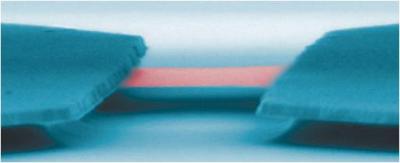A research team headed by scientists at the University of California, Riverside has discovered that a bilayer graphene sheet becomes an insulating material when its electron count comes down to zero, paving the way to use the wonder material as an electronic material in electronics and semiconductor applications.
 Photo shows a scanning electron microscope image of a graphene sheet (red) suspended between two electrodes. The length of the graphene sheet shown is about 1/100 of the width of a human hair. (Credit: Lau lab, UC Riverside)
Photo shows a scanning electron microscope image of a graphene sheet (red) suspended between two electrodes. The length of the graphene sheet shown is about 1/100 of the width of a human hair. (Credit: Lau lab, UC Riverside)
According to one of the researchers, Chun Ning (Jeanie) Lau, bilayer graphene turns out to be an insulating material due to the spontaneous self-assembly of its electrons when their count is minimal. Lau added that the electrons travel orderly rather than moving around haphazardly, a phenomenon termed as 'spontaneous symmetry breaking' that provides mass for particles in physics.
Allan MacDonald, one of the researchers, stated that the team was able to measure the mass of a novel massive quantum particle type that can be determined only within bilayer graphene crystals. MacDonald added that the research work is based on the team’s theoretical work that predicts the emergence of new particles from the electron pool of a bilayer graphene crystal.
The team also discovered that a bilayer graphene’s intrinsic energy gap grows proportionally with the magnetic field, a major breakthrough. It is a known fact that the size of the energy gap decides whether a material is an insulator (large gap), semiconductor (small gap) and metal (no gap). Although single layer graphene has no energy gap, it always acts as a conductor and a metal irrespective of the count of electrons and thus cannot be turned off completely, which makes it unsuitable for electronics applications.
However, bilayer graphene can be turned off, Lau noted. At present, the band gap size is very small for realistic applications, she said. With this finding, the team has now started working on developing trilayer and tetralayer graphenes that may have larger energy gaps suitable for applications such as infrared and digital technologies, she concluded.